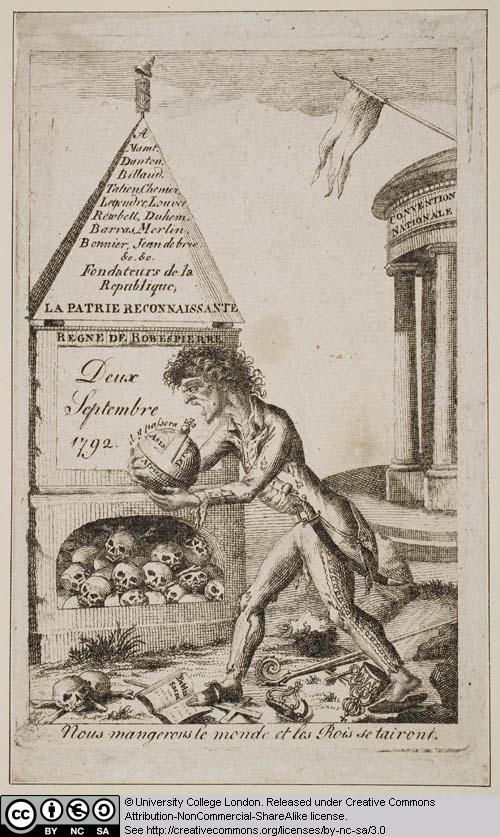16 We will Eat the World

Anon
Nous mangerons le
monde et les Rois se tairont (We will eat the world and the Kings will be
silent) , c.1794 – 1795
Etching
Publisher unrecorded
This print belongs to a body of images that played upon the
fear that Robespierre’s
henchmen’s hunger for human flesh and blood would only be sated when the whole
world had been devoured. The etcher depicts one such follower on the point of
gobbling up a sphere that is at once an orb (a symbol of kingship), and a globe
– we see the continents marked on its surface. He is a truly terrifying figure,
emaciated and dressed in ragged military uniform, he tramples underfoot all
that is sacred, including a holy bible and crucifix, a bishop’s mitre and a
crown.
The scene is set in a barren landscape populated only by the
head of a recently decapitated woman and scattered with skulls, many of which
are piled up in the base of a monument, surmounted by a diminutive (and surely
ironic) liberty bonnet and fasces. Engraved on its surface are the names of
revolutionary politicians that served in the National Convention,
whose building we see to the right. The inscription informs us that they are
the founders of the Republic, declaring ‘La Patrie Reconnaissante’, ‘the
Fatherland is grateful’, an ironic reference to the inscription on the pediment
of the church of St Geneviève, recently renamed the Pantheon and dedicated to
the memory of Great Frenchmen. Beneath this the reign of Robespierre is noted,
as is the date that marked the beginning of the September massacres, one of the
bloodiest episodes in the Revolution’s history.
The reference to cannibalism helps to date the print to the
period immediately following Robespierre’s fall in July 1794, when the backlash
against his rule began. This most inhuman and incomprehensible of crimes was
frequently evoked by orators and artists trying to discredit and make abhorrent
the recent regime. Interestingly, this etcher refuses to let his audience be
complacent: the use of the future tense in his title, and the caption that
follows the curve of the globe, ‘il y passera’, ‘so it will pass’, functions as
a call to arms to destroy such monsters before they destroy you.
Licensed under the Creative Commons Attribution Non-commercial Share Alike 3.0 License
This resource has been released as an open educational resource (OER) on a Creative Commons 'Attribution Non-commercial Share Alike' license. This means that once downloaded, content can be modified and improved to complement a particular course. This requires, however, that improvements are recycled back into the OER community. All content present at the time of download must be accordingly credited and, in turn, novel content must be appropriately licensed.